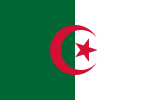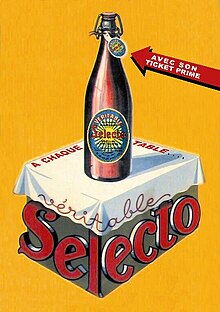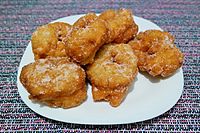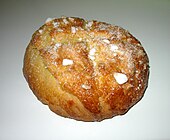Algerian cuisine

| Part of a series on the |
| Culture of Algeria |
|---|
 |
| People |
|
Mythology |
|
Art |
The cuisine of Algeria is influenced by Algeria's interactions and exchanges with other cultures and nations over the centuries.[1] It is based on both land and sea products. Conquests or demographic movement towards the Algerian territory were two of the main factors of exchanges between the different peoples and cultures. The Algerian cuisine is a mix of Arab, Berber, Turkish and French roots.[2][1]
Algerian cuisine offers a variety of dishes depending on the region and the season, but vegetables and cereals remain at its core. Most of the Algerian dishes are centered around bread, meats (lamb, beef or poultry), olive oil, vegetables, and fresh herbs. Vegetables are often used for salads, soups, tajines, couscous, and sauce-based dishes. Of all the Algerian traditional dishes available, the most famous one is couscous, recognized as a national dish.[3]
Ingredients
Algeria, like other Maghreb countries, produces a large range of Mediterranean fruits and vegetables and even some tropical ones.[4] Lamb is commonly consumed. Mediterranean seafood and fish are also eaten.[5]
Meats
Algerians consume a high amount of meat, and it is found in almost every dish.

Meat could traditionally be dried in regions such as Kabylia as a way to preserve the meat for long amounts of time.[citation needed]
The merguez is a type of sausage originating from the Berber people.[7][8][9]
Vegetables
Fish and seafood
Sardines, hake, shrimp, octopus, tuna and cod are the main items of seafood commonly eaten in Algerian cuisine, mostly in stews or fried.
Spices
Many
, and black pepper. Some spice mixes are also traditional to the North African region, such as ras el hanout, which can be made of up to 27 spices. Hror is a spice mix typical of Algerian cuisine mainly made from galangal, cubeb, nutmeg and cinnamon, but recipes may vary and include more spices and herbs such as liquorice or pellitory.[10][11]Dishes

Starters and appetizers
Some small starters can be eaten either before the main dish (traditionally done during
Main dishes

A common and one of the most favorite dishes of Algerian cuisine is
Several pasta dishes can be found in the traditional Algerian cuisine: rechta, chakhchoukha, berkoukes, tikourbabine (also called asban), Aftir oukessoul[14] tlitli or trida.[15] These traditional pasta dishes are prepared in a red stew, with the exception of rechta which is generally made in a white stew in Algeria, with meat and vegetables.
Vegetarian dishes in Algeria are also a main part of the diet with
Some additional dishes include:

- .
- Mhadjeb—flat bread stuffed with onions and tomato sauce.
- Shakshouka, chakshoka, shakhshosha—a mixture of onions, tomato, bell peppers, zucchini and eggs. There many versions, depending on the region.
- Chorba frik or jari—a tomato-base soup with lamb
- Frites-omelette—French fries with eggs
- Dobara—chickpea soup
- Dolma—stuffed vegetables cooked in a stock
Soups
Algeria has four well-known traditional soups consumed throughout the country:
Desserts


Typically, seasonal fruits served as a dessert at the end of meals. These fruits include
Common pastries include dziriyat, garn ghzal (similar to Gazelle ankles), baqlawa, bradj, makroudh, kalb elouz, zlabiya, and griwech (a deep-fried pretzel-shaped dough, soaked in honey and sprinkled with sesame seeds).
Many pastries are prepared for special occasions like for usually served after a woman gave birth.
are generally served with tea and can be topped with honey, jam or even olive oil and sugar.Creponne, a sorbet which originated in Oran, is a specialty in Algeria.[17] Other desserts and cakes such as sfenj and kroki mchawcha are also commonly eaten.
Drinks
Green tea with mint is generally drunk in the afternoon and during ceremonies with pastries.[18] When fresh mint is not available, dried leaves can be used instead. Geranium tea can also be prepared with geranium leaves instead of mint. Generally, tea is prepared with green tea leaves, either of the gunpowder blend or chaara sandook (green tea with a lighter taste than the bitter gunpowder blend).
Algerians are heavy
.
Fruit juice and soft drinks, called gazouz, are common and often drunk daily, the most famous Algerian soda is Hamoud Boualem, an Algerian soft drink manufacturer that makes drinks popular in Algeria and exports them abroad, primarily for consumption by Algerian emigrants. It is one of the country's oldest companies, having been founded in 1878. Their products include sodas like "Selecto," "Hamoud," and "Slim", each in multiple flavors, as well as syrups in different flavors.[21]
Algeria previously produced a large quantity of Algerian wine during the French colonization but production has decreased since its independence; Alcohol consumption is frowned upon in Algeria but is not legally prohibited, which does not prevent the winegrower from producing a wide variety of wines mainly from the slopes of Mascara, Médéa and Tlemcen.[22]
Sauces and condiments
Algerian cuisine is characterized by its use of flavorful spices and herbs, and a variety of sauces play an important role in many dishes. Two popular Algerian sauces are harissa and dersa.
Harissa is a spicy chili paste that is made from dried chili peppers, garlic, olive oil, and various spices such as cumin and coriander. It is often used as a condiment to add heat and flavor to stews, soups, and grilled meats. Harissa can also be used as a marinade for meat or seafood.
Dersa is a milder sauce that is made from garlic, lemon juice, olive oil, and a variety of herbs such as parsley, cilantro, and mint. It is often used as a dipping sauce for bread, vegetables, or grilled meats. Dersa can also be used as a marinade or dressing for salads.
Zaalouk: a traditional dip used in Algeria made from eggplant, tomatoes, garlic, and spices, typically served as an appetizer or side dish.
Chermoula, a marinade made from garlic, cilantro, lemon juice, and spices, commonly used to flavor seafood and meat dishes.
Toum: a garlic sauce made from garlic, lemon juice, and olive oil, similar to aioli, often served with grilled meats or as a dip.
Shakshuka sauce: a spicy tomato sauce made with onions, peppers, and a variety of spices, often used in the popular egg dish of the same name.
Hmiss is another popular condiment in Algerian cuisine. It is a spicy tomato sauce made from roasted red peppers, tomatoes, garlic, olive oil, and chili peppers. Hmiss is usually served as a dip or spread with bread or grilled meat, and it can also be used as a topping for sandwiches or pizza. The roasted red peppers give hmiss a smoky flavor, while the chili peppers add heat, making it a flavorful and spicy condiment. In some parts of Algeria, hmiss is also made with the addition of spices such as cumin and paprika, giving it a unique regional variation. Hmiss is a versatile sauce that adds a delicious kick to many dishes, and it is a favorite condiment among Algerians.
Bread
Between 1976 and 1984, the average Algerian family spent around 56% of their income on food and drink, and more than 10% of that number was spent on bread and other cereal products. Bread is thought to contain God's blessing, baraka. It is traditionally seen as a symbol of life and functions in rituals symbolic of life, fertility and abundance.[23]
Types of breads

Khubz as-dâr—wheat flour, water, salt and yeast. Traditionally flat and round, a few centimeters thick, made at home and commonly baked in a gas oven or communal oven.
Khubz at-tajîn or matlû—wheat semolina, yeast, water and salt. Flattened pan-bread (French: galette), baked in a previously heated earthenware or cast-iron plate on a fire. Variations are made by the quality of the leavening agent, by adding barley or sorghum, bran, or by making it corn-based.
Khubz-ftir, raqâq, rfîs or tarîd—well-kneaded, unleavened dough, baked for half a minute on a convex sheet of brass or iron, balanced on stones over a fire. This is a preferred method for those living nomadic lives due to easy transportation of pan and little amount of fuel necessary.
Batbout is a small bread resembling Greek pita bread, albeit thicker (similar to matlû). It is eaten with stuffing inside.
French
Algerian bread
French bread tends to be given more value in terms of taste and quality in that it was commonly associated to being more suitable to higher standards. However, the white inner parts of a baguette are thought to be unhealthy and will regularly be thrown away, and the bread is frequently associated with constipation.
Algerian breads, on the other hand, are considered more nutritive, rich and tasteful and seldom go to waste. Because French breads harden over night or become chewy when put away in plastic bags, it is hard to find usage for them, so they are thrown away with more frequency than Algerian breads that can be reheated or reutilized as edible food utensils or even bird feed.
In the context of rituals, only Algerian bread is thought suitable. Breads offered to guests should be homemade, as it signifies the essence, intimacy, and qualities of the family. In daily practices, it is also a sign of wealth and affluence if one has extra bread at the table, and making bread at home can be considered a sign of familial economic independence.[23]
Commonly eaten breads in Algeria consist of Kesra, Matlouh, Mtabga and Mouna.
Gallery
-
Kalb el Louz, a popular Algerian dessert
-
Algerian makroud
-
Algerian couscous from Kabylia
-
Algerian chakhchoukha from the city of Biskra
-
Traditional Algerian olive tagine with chicken and mushrooms
-
Creponne, a specialty in Algeria
-
Algerian home-made bread
-
Algerian sfenj
-
Kesra
-
Mouna, sweet bread of Algerian origin
-
Algerian rogag
See also
- Arab cuisine
- Berber cuisine
- Mediterranean cuisine
- North African cuisine
- List of African cuisines
References
- ^ a b "Culture, Traditions, Cuisine". Encyclopedia Britannica. August 12, 1998. Retrieved April 2, 2024.
- ^ "The Cuisine of Algeria". WorldAtlas. 2019-06-13. Retrieved 2023-12-19.
- ^ "Food Cultures of the World Encyclopedia 4 volumes 0313376263, 9780313376269". ebin.pub. June 10, 2005. p. 17. Retrieved April 2, 2024.
- ^ "Food in Algeria". Food in Every Country (website). Accessed May 2010.
- ISBN 978-3-030-96267-8, retrieved 2023-05-05
- ^ "Food in Algeria". World Food Wine. Retrieved 2023-08-23.
- ^ French words: Past, Present, and Future. M.H. Offerd. 2001. Page 89.
- ^ Research in African Literatures. Volume 34. 2003. Page 34.
- ^ Merquez and Qadid, North-African preserved meats.
- ISBN 978-2-296-51498-0.
- ISBN 978-9961-780-73-2.
- ^ "Luce Ben Aben, Moorish Women Preparing Couscous, Algiers, Algeria". World Digital Library. 1899. Retrieved 2013-09-26.
- ^ "El-Hammoum, un Couscous avant LE Couscous". 2021.
- ^ "Aftir oukessoul de Béjaïa". Cuisine Algérie. November 30, 2013. Retrieved August 29, 2020..
- ^ OCLC 1243890366.
- ^ "Gaspacho oranais ou manchego". Coundris.chez-alice.fr. Retrieved 2014-08-27.
- ^ KOI VOIR A ORAN GOUAL GOUAL
- ISBN 978-2-7469-5576-9.
- ^ Ukers, William Harrison (1922). All About Coffee. Tea and Coffee Trade Journal Company. pp. 655–656.
- ^ Doctor, Vikram (April 20, 2012). "Coffee Song: A rethink on Coffee". The Economic Times. Retrieved 2 November 2014.
- ^ "Accueil". www.hamoud-boualem.com. Retrieved 2022-06-12.
- JSTOR 23441368.
- ^ a b c Jansen, Willy. “French Bread and Algerian Wine: Conflicting Identities in French Algeria.” In Food, Drink and Identity: Cooking, Eating and Drinking in Europe Since the Middle Ages, edited by Peter Scholliers, pp. 195-218. Oxford: Berg, 2001











